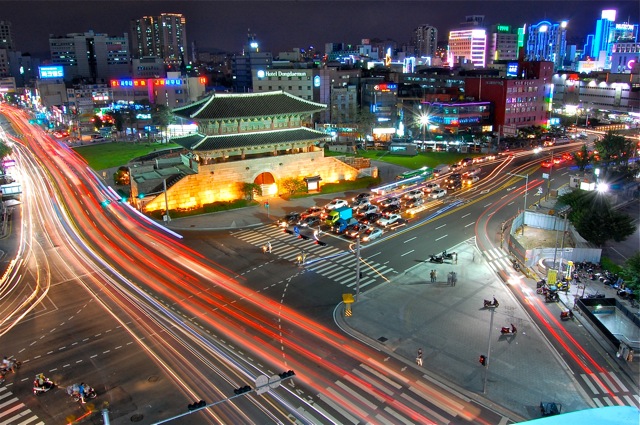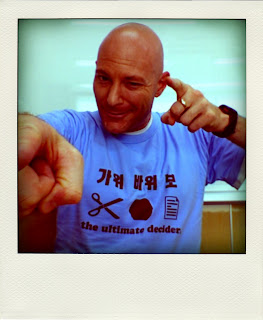
The area around Dongdaemun Gate is home to some of Seoul's best bargain shopping. ~ Photo P. DeMarco
Whether you are about to attend the G20 or are heading to this dynamic city for fun, Seoul is the place to be. Looking for something to do? Where to eat or sleep? Check out this article I wrote and photographed for the Philippine Airlines inflight magazine Mabuhay and learn more about the “Miricale on the Han River.”
[View published version in PDF format here]
Seoul: City of Infinite Discoveries
Throw away your misconceptions and nip into fast changing Seoul where the energy is as hot as kimchi. PETER DEMARCO shows us around this dynamic city.
An 89 year old man sits in Seoul’s Tapgol Park in the shadow of a ten-story marble pagoda dating back to the Jeoseon Dynasty, some 500 years ago. He rests his hands on a twisted black wooden cane, wearing traditional white baggy clothes or hanbok: the clothing all Koreans once wore on a daily basis, but now only wear during festive occasions like weddings or national holidays. He sits quietly, alone, still, as if comforted by the cultural relics that surround him, while life in this mega city explodes around him.
Seoul really is the “city of infinite discoveries” as the local board of tourism boasts. As you walk the streets of this capital city, you get the feeling that something important or interesting is happening somewhere. The energy on the city streets is so strong you almost don’t want to sleep for fear that you’ll miss out on something.
It’s easy to understand why this city is so dynamic once you realize Seoul is Korea. Although the city’s population is around 11 million, almost half of all Koreans – or 25 million people – live within 2 hours of the city center. It is the nerve center of the country both politically, culturally, and economically.
Life Around Town
A few blocks away from Tapgol Park in the Bukchon neighborhood, a fashion photographer snaps pictures of a tall Korean beauty under the shade of trees that line the street. She’s modeling the latest black leather bag, holding it like a badge of recognition that screams “I’m a VIP, look at me!”
A group of friends giggle as they walk by shopping for shoes, clothes, and a quirky neighborhood cafe to relax in. On the hill above, a couple get’s lost in the alleyways of a cluster of traditional wooden houses with black tile roofs. Fortunately, many of these charming old-style houses or hanok have been preserved instead of being demolished to make way for a new shops or modern-looking houses.
Down the road, inside Gyeongbokgung Palace, next to a grassy field by the Folk Art Museum, Korean performers in traditional dress practice for an afternoon concert. They sing folk songs that have been sung for centuries, their voices echo eerily around the palace grounds.
The pulse of Seoul can be felt wherever you go. From tea houses to temples, markets to museums, it’s obvious the city is alive.
December Lights
In the winter, Seoul puts on a show as thousands of multi-colored lights blanket the city’s cultural hotspots. Since 25% of Korean’s claim to be Christian, the country celebrates Christmas with lights and Christmas trees, making for a festive atmosphere. But make sure to dress warmly as temperatures can drop below freezing in the winter months.
For an especially extravagant show of lights, be sure to head over to Cheonggyecheon Stream (Metro line 5, Gwanghwamun Station, exit 5, walk towards Cheonggye Plaza; free). This 3 kilometer tree-lined stream was once covered by an overpass but is now a favorite place for tourists and locals alike to go for a romantic stroll or have a relaxing picnic with friends.
For an even more spectacular view of the city lights, head to N Tower (also known as Seoul Tower) on Namsan Mtn. Take in the city views from the observation deck or sip coffee while overlooking Seoul at the cafe on the floor below. You can hike to the top of the mountain or take the cable car (line 4, Myeong-dong Station, Exit 3, cablecar.co.kr.; 7,000 won R/T) for a less strenuous trip.
No matter what time of year you decide to visit, you’re guaranteed to always find something interesting. In fact, you don’t even have to go out and search for adventure. Just do as those from Seoul do: sit in the park and let the city open up to you.
Websites
Korean Tourism Board
Hi Seoul
Official Seoul City Tourism Website
Seoul Travel Tips
- Seoul is one of the safest cities in Asia and the world. Theft or violent crimes are rare.
- Public transportation is extremely clean and efficient. You can take the subway to most major tourist destinations.
- Be sure to stop by one of the many tourist information centers for free maps and assistance in English.
- Although most Korean’s can’t speak English very well, people from Seoul tend to have more experience interacting with foreigners so it is possible to find some English speakers. It would be best to bring along a phrasebook though.
Where to Eat
- Dokdo Cham Chi: Korean’s, like their Japanese neighbors, have an insatiable appetite for raw fish or whay as the locals say. One of their favorite types of raw fish is tuna or cham chi. If you want to try fish that practically melts in your mouth, stop by this “tuna house” located right next to the Jungno 3-ga metro station. [Myeong-dong, Jungno-gu, +82-2-762-6537; 25,000 won]
- Bok Cheon Kalguksu: You can’t leave Seoul without trying one of Korea’s signature dishes – kalguksu or handmade wheat flour “knife noodles”. For an even more authentic treat, try the Kongguksu or cold green chewy noodles in a frothy, creamy, nutty-like broth of ground soybean, topped with sesame seeds, sliced cucumber and a cherry tomato. The perfect place to stop after visiting Gyeongbokgun Palace next door. (Jongno-gu, Sogyuk Dong, +82-2-739-6334; 7,000 won]
- Parksee Moolko On Jebee: This quirky restaurant in the heart of the artsy Insadong neighborhood serves up Korean favorites like pajun, also known as a Korean Pancake, which is made of rice flour and filled with vegetables and seafood such as squid or oysters, then fried. So delicious! Especially when you wash it down with the house specialty: fermented milky-like ginseng-flavored rice wine called dongdongju. [Kwanhun-dong, Jongro-gu, +82-2-723-3200; 20,000 won]
Where to Stay
- Banana Backpackers: For the budget conscious traveller, this hostel offers clean and safe accommodation next to many of Seoul’s major attractions as well as free kitchen, internet, luggage storage, laundry facilities and more. [30-1, Iksun-dong, Jongno-gu, +82-2-3672-1973, bananabackpackers.com; dorm bed 20,000 won, single 35,000, double 45,000 won]
- Seoul Guesthouse: Why not stay in a traditional wooden house while in Seoul? If you want to live like a local, try one of the many hanok guesthouses like this one located between the city’s two royal palaces. [135-1 Gyedong Jongro-gu, +82-2-745-0057, seoul110.com; single 35,000 won, twin 50,000]
- W Seoul: This award-winning hotel’s cutting edge design and modern amenities like an indoor pool with a panoramic view of the city, Turkish bath and spa, driving range, and 5 star kitchen, make it one of the most desired and trendy places to stay when in Seoul. [21 Gwangjang-dong, Gwangjin-gu, +82-2-465-2222, wseoul.com; Double room weekend 375,000 won, weekday 255,000 won, see website for special weekend packages]
Where to Shop
- Myongdong: If you’re looking to buy the latest fashions at the best prices, this maze of stores and neon signs is crammed daily with Seoul’s trendy bargain hunters. From high heels and jeans, to jackets and suits, you can find all the designer labels and much more. A sight not to be missed! Similar alternatives are Namdaemun market or Dongdaemun market (great for night shopping). Take subway line 4 to Myeongdong Station.
- Yongsan Market: Cameras, MP3 players, computers, cell phones, and every other electronic imaginable practically spill out of the stores at Seoul’s technological-Mecca of markets. Over 5,000 shops are crammed into twenty or so buildings, making it a technophile’s dreamworld. If you want to get the best value for your money be ready to haggle and bargain your way to deeply discounted prices. Take subway line 1 to Yongsan Station.
- Shinsegae Department Store: Gucci, Prada, Armani, Hermes, Dior: “house of haute couture” is a more fitting name than department store for this high-end shoppers paradise. Be sure to check out the fine foods market in the basement. Take subway line 4 to Hoehyun Station.
Typical Characteristics of Koreans from Seoul
When asked what people from Seoul tobagi or locals are like, Mr. Pak, a 30 something executive educated in America said jokingly as he smoked a cigarette with his colleagues: “sparkling!” He was referring to the country’s latest ad campaign: “Korea, Sparkling!” According to the Korea Tourism Organization, the new slogan is a metaphor for Korea’s passionate and warmhearted people, unique and creative 5,000 year old culture, and changing landscapes and seasons.
Mr. Pak went on to say in a more serious tone that people from Seoul tend to be more liberal and open to new and different ideas. He described Seoul as being a type of “cultural hotpot” where people from all over Korea and the world come to make a living. Kim Bo Hyun, a college student living on the outskirts of Seoul described the city and its people as being more trendy, unique, and fashionable than the rest of the country.
Kimchi Trivia
Even if you haven’t been to Korea, chances are you’ve already heard about kimichi. But what is it really? Kimchi is fermented vegetables in seasoning – most often onions, garlic, and chili peppers which give it a spicy red color.
When most people think of kimchi, they picture the most popular type which is the red baechu or Chinese cabbage kimchi. However, kimchi is not always red or made with cabbage. The Korean Food Academy states there are actually over 100 different types of kimchi, and references to kimchi date as far back as 2,600 to 3,000 years ago.
Kimchi is such an important part of Korean culture that the locals believe in “kimchi power” or the supposed ability of this pickled concoction to cure almost any type of ailment from cancer to SARS. Actually, kimchi contains about 80% of the daily recommend amount of vitamin C and carotene. It also has high levels of vitamin A, thiamine (B1), riboflavin (B2), calcium, and iron.




 RSS Feed
RSS Feed



Recent comments